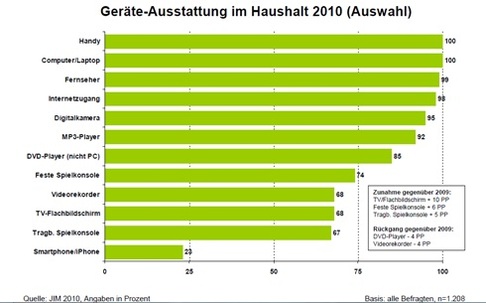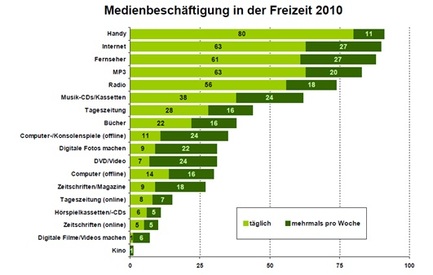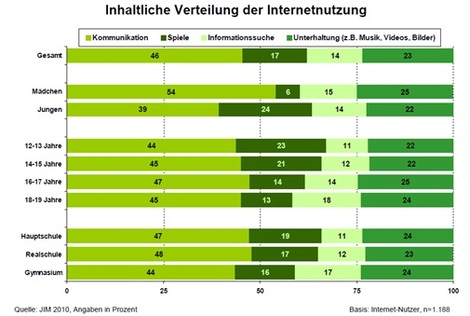Mediakids - JIM-Study
This essay will focus on the JIM-Study 2010 commissioned by the Pedagogical Media Research Centre Southwest. This is a German institution which investigates media consumption by young people. Therefore, the abbreviation JIM stands for the German terms Jugend (youth), Information (information) and Mulit-Media (multimedia). The study is conducted every year, and the study of 2010 is the 13th one. In this study, 1208 adolescents were interviewed about their use of new media etc. via telephone. The youth who took part in the survey were between 12 and 19 years old and attended different kinds of schools.
What is important is that the study provides us with significant information about the relationship between youth and media. The results of this study show how important the use of new media is for pupils and therefore helps to understand why new media should not be excluded from today`s lessons.
In the following, I will present some of the results of the JIM-Study and will also point out the implications the results have for teaching whenever possible. Thereby, the diagrams displayed on this page and the figures you can find in the text are all taken from the JIM-Study 2010. The original study can be accessed by clicking on the following link: www.mpfs.de/fileadmin/JIM-pdf10/JIM2010.pdf
Unfortunately, as the JIM-Study is a German study, the labels on the diagrams are in German. Due to that, I will always explain the most important statements of the diagrams next (before or after) to them.
Media equipment of adolescents and their families
The first aspect the JIM-Study investigated was the media equipment of the adolescents and their families. One of the most important results is that nearly every family owns a tv, a mobile phone, a computer, and has access to the internet. This is also shown in the diagram inserted below:
What is important is that the study provides us with significant information about the relationship between youth and media. The results of this study show how important the use of new media is for pupils and therefore helps to understand why new media should not be excluded from today`s lessons.
In the following, I will present some of the results of the JIM-Study and will also point out the implications the results have for teaching whenever possible. Thereby, the diagrams displayed on this page and the figures you can find in the text are all taken from the JIM-Study 2010. The original study can be accessed by clicking on the following link: www.mpfs.de/fileadmin/JIM-pdf10/JIM2010.pdf
Unfortunately, as the JIM-Study is a German study, the labels on the diagrams are in German. Due to that, I will always explain the most important statements of the diagrams next (before or after) to them.
Media equipment of adolescents and their families
The first aspect the JIM-Study investigated was the media equipment of the adolescents and their families. One of the most important results is that nearly every family owns a tv, a mobile phone, a computer, and has access to the internet. This is also shown in the diagram inserted below:
When looking at the youth and not only considering their whole families, it becomes obvious that a vast majority possesses an own computer or laptop, and more than half of them even have got an own access to the internet.
Concerning younger children (12-13 years old), the number of pupils owning an own computer is a little lower (65%), but still more than half of the students questioned are well equipped. About 91% of all pupils can even access the world wide web from their own rooms and 39% can at least use a computer available at home.
Already these figures show that computers and the internet are an integral component of the media equipment of every family. Therefore, children are used to working with those tools and grow up with them. As this is the case, it becomes obvious that computers and the internet should not be excluded from school and should also be used when teaching foreign languages. In order to use computers etc. appropriately, we, as future teachers, should build up sufficient computer knowledge. If we do not work with these tools and always try to widen and improve our knowledge, the pupils will be able to operate with those tools better than we are. All of this shows that teachers should really be instructed in the field of new media and attend some classes or advanced education programs in this field.
Use of media in free time
Apart from the media equipment in general, the JIM-Study also questioned the adolescents about their use of media in their free time. Their answers are displayed in the following diagram:
Concerning younger children (12-13 years old), the number of pupils owning an own computer is a little lower (65%), but still more than half of the students questioned are well equipped. About 91% of all pupils can even access the world wide web from their own rooms and 39% can at least use a computer available at home.
Already these figures show that computers and the internet are an integral component of the media equipment of every family. Therefore, children are used to working with those tools and grow up with them. As this is the case, it becomes obvious that computers and the internet should not be excluded from school and should also be used when teaching foreign languages. In order to use computers etc. appropriately, we, as future teachers, should build up sufficient computer knowledge. If we do not work with these tools and always try to widen and improve our knowledge, the pupils will be able to operate with those tools better than we are. All of this shows that teachers should really be instructed in the field of new media and attend some classes or advanced education programs in this field.
Use of media in free time
Apart from the media equipment in general, the JIM-Study also questioned the adolescents about their use of media in their free time. Their answers are displayed in the following diagram:
In this diagram, you can see that about 90% of the children use their mobile phones as well as the internet regularly (more than once per week). Also television, mp3-players and the radio are often switched on. When considering the importance of these media for the youth in their daily lives, 86% answer that the internet is the most important part of media. Only listening to music has higher rates (91%). Again these figures show that the internet has become an important part of media for today`s children. Excluding it from our foreign language classes would not pay attention to the pupils` needs who really need to work with these tools.
Together with the data about how many children have access to the internet in general, these findings show that using the computer for teaching purposes is no problem anymore. If the teacher gives some homework for which a computer or online tool should be used, every pupil has the possibility and the technical equipment to fulfill the tasks. Nevertheless, teachers should always keep a balance between using classical media and methods and using new media. The new media should only be used when really appropriate and not just for fun.
Purposes for which computers and the internet are used
To go into more detail about the importance of new media, the researchers also investigated the purposes for which the computer and the internet are used. Here, the most significant finding is that the internet is mostly used for communication purposes (be it via social networks or e-mail). More than half of the respondents communicate via e-mail at least two times per week.
Together with the data about how many children have access to the internet in general, these findings show that using the computer for teaching purposes is no problem anymore. If the teacher gives some homework for which a computer or online tool should be used, every pupil has the possibility and the technical equipment to fulfill the tasks. Nevertheless, teachers should always keep a balance between using classical media and methods and using new media. The new media should only be used when really appropriate and not just for fun.
Purposes for which computers and the internet are used
To go into more detail about the importance of new media, the researchers also investigated the purposes for which the computer and the internet are used. Here, the most significant finding is that the internet is mostly used for communication purposes (be it via social networks or e-mail). More than half of the respondents communicate via e-mail at least two times per week.
This data indicates that almost all pupils possess an own e-mail account or know how to register for one. This is an important finding, because many online tools require a registration with an existing e-mail address, and it is not always possible for the teacher to create class accounts.
In contrast to communicating via the internet, less children use it to search for information. If they do so, they most often use the well known search engines like google. The study has shown that 79% use google etc. at least twice per week. This is an aspect we should keep in mind in our lesson planning. We as teachers should teach our pupils how to search for information and how to use these search engines efficiently. Besides, we should also provide our pupils with some criteria they can stick to in order to judge whether a website is reliable or not.
Apart from communicating and searching for information, pupils also make use of video platforms like YouTube. About 60% of the pupils between 12 and 19 use these tools more than once per week. Due to this finding, it becomes obvious that videos available on the internet can and should be used for teaching purposes, too. The pupils watch videos in their free time, as well, and therefore video clips meet the pupils` interests. Simultaneously, they can improve the listening skills (especially if a native speaker is talking) of the pupils. One idea might be to use the program Dragontape, for instance. With this tool, the pupils can create a film out of individual video clips available on YouTube. What a product can actually look like can be found under my tasks for presenting content (dragontape).
What the pupils are less used to is the preparation of presentations or the editing of pictures or films themselves. This is a point we should definitively teach our students. In today`s world, presentations are an obligatory part of many jobs, and therefore, the pupils should be able to prepare them with the help of new media. The importance of the ability to hold convincing presentations is even highlighted in the German abitur where presentations can be part of the assessment. In order to teach our students how to prepare a good presentation, we should introduce them to different software tools. To mention are of course PowerPoint, but also online tools like prezi.com which allows creating a zooming presentation.
All in all, this study shows that new media should be included in today`s teaching. If one does not use any new media from time to time and when appropriate, one ignores the pupils` living reality.
Apart from that, the study makes me think about additional implications for my future teaching. As most of the pupils regularly use a computer and the internet, we have to teach them how to use it correctly in order to limit the dangers. The pupils have to be informed about and aware of copyright issues, about how they can protect their data on the internet (see essay about data protection), and how they should behave online (e.g. prevent cyberbullying).
I can really recommend to read the JIM-Study and to think about the implications the findings have on contemporary teaching.
In contrast to communicating via the internet, less children use it to search for information. If they do so, they most often use the well known search engines like google. The study has shown that 79% use google etc. at least twice per week. This is an aspect we should keep in mind in our lesson planning. We as teachers should teach our pupils how to search for information and how to use these search engines efficiently. Besides, we should also provide our pupils with some criteria they can stick to in order to judge whether a website is reliable or not.
Apart from communicating and searching for information, pupils also make use of video platforms like YouTube. About 60% of the pupils between 12 and 19 use these tools more than once per week. Due to this finding, it becomes obvious that videos available on the internet can and should be used for teaching purposes, too. The pupils watch videos in their free time, as well, and therefore video clips meet the pupils` interests. Simultaneously, they can improve the listening skills (especially if a native speaker is talking) of the pupils. One idea might be to use the program Dragontape, for instance. With this tool, the pupils can create a film out of individual video clips available on YouTube. What a product can actually look like can be found under my tasks for presenting content (dragontape).
What the pupils are less used to is the preparation of presentations or the editing of pictures or films themselves. This is a point we should definitively teach our students. In today`s world, presentations are an obligatory part of many jobs, and therefore, the pupils should be able to prepare them with the help of new media. The importance of the ability to hold convincing presentations is even highlighted in the German abitur where presentations can be part of the assessment. In order to teach our students how to prepare a good presentation, we should introduce them to different software tools. To mention are of course PowerPoint, but also online tools like prezi.com which allows creating a zooming presentation.
All in all, this study shows that new media should be included in today`s teaching. If one does not use any new media from time to time and when appropriate, one ignores the pupils` living reality.
Apart from that, the study makes me think about additional implications for my future teaching. As most of the pupils regularly use a computer and the internet, we have to teach them how to use it correctly in order to limit the dangers. The pupils have to be informed about and aware of copyright issues, about how they can protect their data on the internet (see essay about data protection), and how they should behave online (e.g. prevent cyberbullying).
I can really recommend to read the JIM-Study and to think about the implications the findings have on contemporary teaching.



